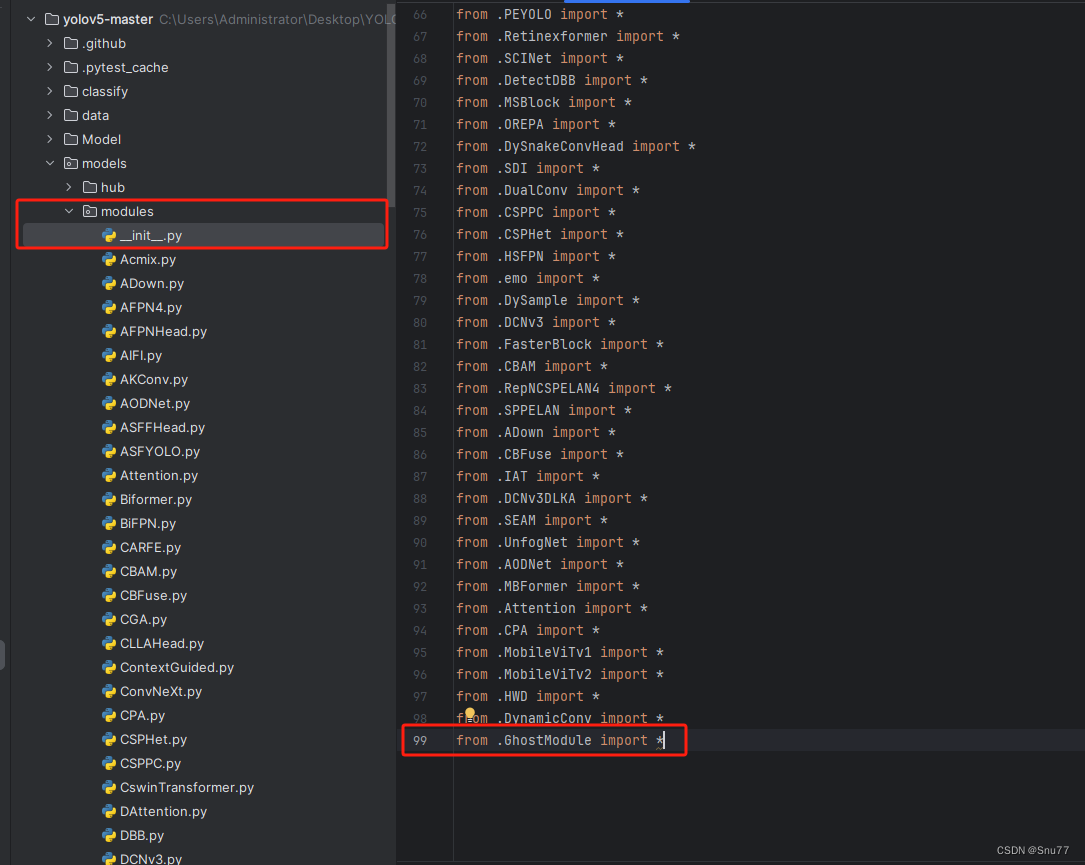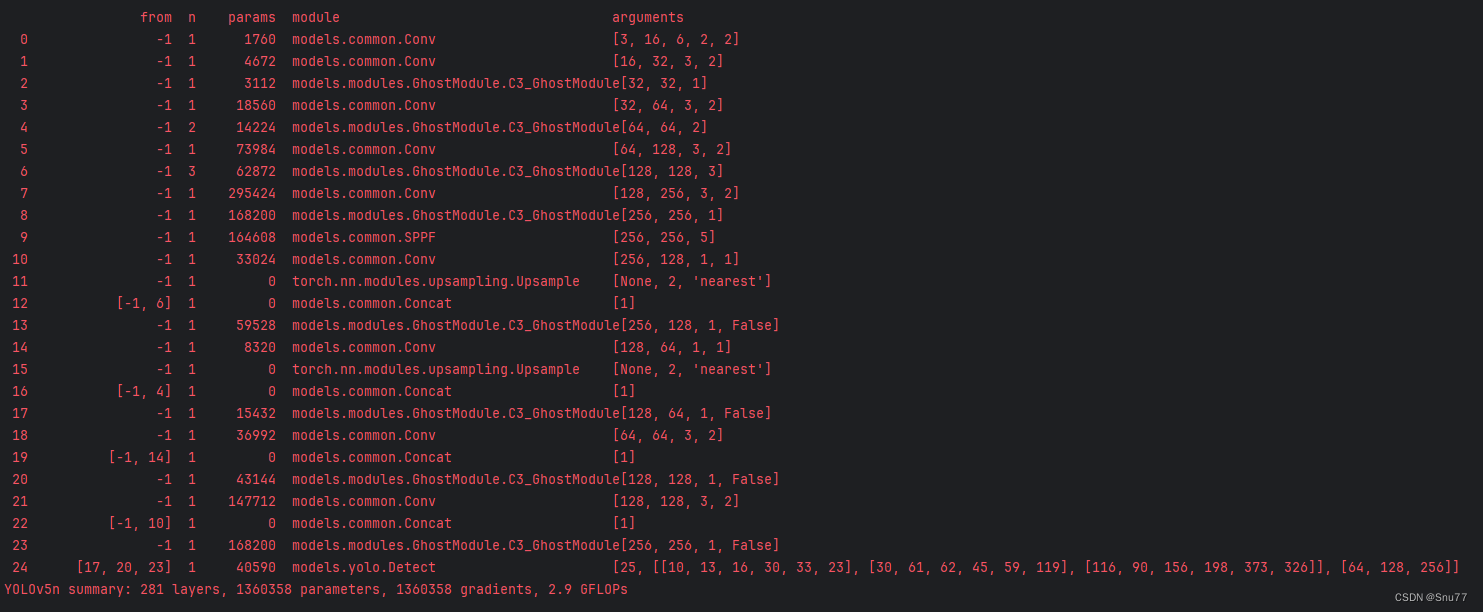一、本文介绍
本文给大家带来的改进机制是CVPR2024的最新改进机制DynamicConv其是CVPR2024的最新改进机制,这个论文中介绍了一个名为ParameterNet的新型设计原则,它旨在在大规模视觉预训练模型中增加参数数量,同时尽量不增加浮点运算(FLOPs),所以本文的DynamicConv被提出来了,使得网络在保持低FLOPs的同时增加参数量,在其提出的时候它也提出了一个新的模块hostModule,我勇其魔改C2f从而达到创新的目的,在V5n上其参数量仅有130W计算量为2.9GFLOPs,从而允许这些网络从大规模视觉预训练中获益。
欢迎大家订阅我的专栏一起学习YOLO!

专栏回顾:YOLOv5改进专栏——持续复现各种顶会内容——内含100+创新
目录
一、本文介绍
二、原理介绍
三、核心代码
四、手把手教你添加GhostModule模块
4.1 GhostModule添加步骤
4.1.1 修改一
4.1.2 修改二
4.1.3 修改三
4.1.4 修改四
4.2 GhostModule的yaml文件和训练截图
4.3GhostModule的训练过程截图
五、本文总结
二、原理介绍

官方论文地址: 官方论文地址点击此处即可跳转
官方代码地址: 官方代码地址点击此处即可跳转
动态卷积(Dynamic Convolution)是《DynamicConv.pdf》中提出的一种关键技术,旨在增加网络的参数量而几乎不增加额外的浮点运算(FLOPs)。以下是关于动态卷积的主要信息和原理:
主要原理:
1. 动态卷积的定义:
动态卷积通过对每个输入样本动态选择或组合不同的卷积核(称为"experts"),来处理输入数据。这种方法可以视为是对传统卷积操作的扩展,它允许网络根据输入的不同自适应地调整其参数。
2. 参数和计算的动态化:
在动态卷积中,不是为所有输入使用固定的卷积核,而是有多个卷积核(或参数集),并且根据输入的特性动态选择使用哪个核。
这种选择通过一个学习得到的函数(例如,使用多层感知机(MLP)和softmax函数)来动态生成控制各个卷积核贡献的权重。
3. 计算过程:
给定输入特征,和一组卷积核
,每个核对应一个专家。
每个专家的贡献由一个动态系数
控制,这些系数是针对每个输入样本动态生成的。
输出是所有动态选定的卷积核操作的加权和:
其中表示卷积操作,
是通过一个小型网络(如MLP)动态计算得出的,这个小网络的输入是全局平均池化后的特征。
动态卷积的优点:
- 参数效率高:通过共享和动态组合卷积核,动态卷积可以在增加极少的计算成本的情况下显著增加模型的参数量。
- 适应性强:由于卷积核是针对每个输入动态选择的,这种方法可以更好地适应不同的输入特征,理论上可以提高模型的泛化能力。
- 资源使用优化:动态卷积允许模型在资源有限的环境中(如移动设备)部署更复杂的网络结构,而不会显著增加计算负担。
动态卷积的设计思想突破了传统卷积网络结构的限制,通过动态调整和优化计算资源的使用,实现了在低FLOPs条件下提升网络性能的目标,这对于需要在计算资源受限的设备上运行高效AI模型的应用场景尤为重要。
三、核心代码
核心代码的使用方式看章节四!
"""
An implementation of GhostNet Model as defined in:
GhostNet: More Features from Cheap Operations. https://arxiv.org/abs/1911.11907
The train script of the model is similar to that of MobileNetV3
Original model: https://github.com/huawei-noah/CV-backbones/tree/master/ghostnet_pytorch
"""
import math
from functools import partial
import torch
import torch.nn as nn
import torch.nn.functional as F
from timm.layers import drop_path, SqueezeExcite
from timm.models.layers import CondConv2d, hard_sigmoid, DropPath__all__ = ['C3_GhostModule']_SE_LAYER = partial(SqueezeExcite, gate_fn=hard_sigmoid, divisor=4)class DynamicConv(nn.Module):""" Dynamic Conv layer"""def __init__(self, in_features, out_features, kernel_size=1, stride=1, padding='', dilation=1,groups=1, bias=False, num_experts=4):super().__init__()self.routing = nn.Linear(in_features, num_experts)self.cond_conv = CondConv2d(in_features, out_features, kernel_size, stride, padding, dilation,groups, bias, num_experts)def forward(self, x):pooled_inputs = F.adaptive_avg_pool2d(x, 1).flatten(1) # CondConv routingrouting_weights = torch.sigmoid(self.routing(pooled_inputs))x = self.cond_conv(x, routing_weights)return xclass ConvBnAct(nn.Module):""" Conv + Norm Layer + Activation w/ optional skip connection"""def __init__(self, in_chs, out_chs, kernel_size, stride=1, dilation=1, pad_type='',skip=False, act_layer=nn.ReLU, norm_layer=nn.BatchNorm2d, drop_path_rate=0., num_experts=4):super(ConvBnAct, self).__init__()self.has_residual = skip and stride == 1 and in_chs == out_chsself.drop_path_rate = drop_path_rate# self.conv = create_conv2d(in_chs, out_chs, kernel_size, stride=stride, dilation=dilation, padding=pad_type)self.conv = DynamicConv(in_chs, out_chs, kernel_size, stride, dilation=dilation, padding=pad_type,num_experts=num_experts)self.bn1 = norm_layer(out_chs)self.act1 = act_layer()def feature_info(self, location):if location == 'expansion': # output of conv after act, same as block coutputinfo = dict(module='act1', hook_type='forward', num_chs=self.conv.out_channels)else: # location == 'bottleneck', block outputinfo = dict(module='', hook_type='', num_chs=self.conv.out_channels)return infodef forward(self, x):shortcut = xx = self.conv(x)x = self.bn1(x)x = self.act1(x)if self.has_residual:if self.drop_path_rate > 0.:x = drop_path(x, self.drop_path_rate, self.training)x += shortcutreturn xclass GhostModule(nn.Module):def __init__(self, inp, oup, kernel_size=1, ratio=2, dw_size=3, stride=1, act_layer=nn.ReLU, num_experts=4):super(GhostModule, self).__init__()self.oup = oupinit_channels = math.ceil(oup / ratio)new_channels = init_channels * (ratio - 1)self.primary_conv = nn.Sequential(DynamicConv(inp, init_channels, kernel_size, stride, kernel_size // 2, bias=False, num_experts=num_experts),nn.BatchNorm2d(init_channels),act_layer() if act_layer is not None else nn.Sequential(),)self.cheap_operation = nn.Sequential(DynamicConv(init_channels, new_channels, dw_size, 1, dw_size // 2, groups=init_channels, bias=False,num_experts=num_experts),nn.BatchNorm2d(new_channels),act_layer() if act_layer is not None else nn.Sequential(),)def forward(self, x):x1 = self.primary_conv(x)x2 = self.cheap_operation(x1)out = torch.cat([x1, x2], dim=1)return out[:, :self.oup, :, :]class GhostBottleneck(nn.Module):""" Ghost bottleneck w/ optional SE"""def __init__(self, in_chs, out_chs, dw_kernel_size=3,stride=1, act_layer=nn.ReLU, se_ratio=0., drop_path=0., num_experts=4):super(GhostBottleneck, self).__init__()has_se = se_ratio is not None and se_ratio > 0.self.stride = stridemid_chs = in_chs * 2# Point-wise expansionself.ghost1 = GhostModule(in_chs, mid_chs, act_layer=act_layer, num_experts=num_experts)# Depth-wise convolutionif self.stride > 1:self.conv_dw = nn.Conv2d(mid_chs, mid_chs, dw_kernel_size, stride=stride,padding=(dw_kernel_size - 1) // 2, groups=mid_chs, bias=False)self.bn_dw = nn.BatchNorm2d(mid_chs)else:self.conv_dw = Noneself.bn_dw = None# Squeeze-and-excitationself.se = _SE_LAYER(mid_chs, se_ratio=se_ratio,act_layer=act_layer if act_layer is not nn.GELU else nn.ReLU) if has_se else None# Point-wise linear projectionself.ghost2 = GhostModule(mid_chs, out_chs, act_layer=None, num_experts=num_experts)# shortcutif in_chs == out_chs and self.stride == 1:self.shortcut = nn.Sequential()else:self.shortcut = nn.Sequential(DynamicConv(in_chs, in_chs, dw_kernel_size, stride=stride,padding=(dw_kernel_size - 1) // 2, groups=in_chs, bias=False, num_experts=num_experts),nn.BatchNorm2d(in_chs),DynamicConv(in_chs, out_chs, 1, stride=1, padding=0, bias=False, num_experts=num_experts),nn.BatchNorm2d(out_chs),)self.drop_path = DropPath(drop_path) if drop_path > 0. else nn.Identity()def forward(self, x):shortcut = x# 1st ghost bottleneckx = self.ghost1(x)# Depth-wise convolutionif self.conv_dw is not None:x = self.conv_dw(x)x = self.bn_dw(x)# Squeeze-and-excitationif self.se is not None:x = self.se(x)# 2nd ghost bottleneckx = self.ghost2(x)x = self.shortcut(shortcut) + self.drop_path(x)return xdef autopad(k, p=None, d=1): # kernel, padding, dilation"""Pad to 'same' shape outputs."""if d > 1:k = d * (k - 1) + 1 if isinstance(k, int) else [d * (x - 1) + 1 for x in k] # actual kernel-sizeif p is None:p = k // 2 if isinstance(k, int) else [x // 2 for x in k] # auto-padreturn pclass Conv(nn.Module):"""Standard convolution with args(ch_in, ch_out, kernel, stride, padding, groups, dilation, activation)."""default_act = nn.SiLU() # default activationdef __init__(self, c1, c2, k=1, s=1, p=None, g=1, d=1, act=True):"""Initialize Conv layer with given arguments including activation."""super().__init__()self.conv = nn.Conv2d(c1, c2, k, s, autopad(k, p, d), groups=g, dilation=d, bias=False)self.bn = nn.BatchNorm2d(c2)self.act = self.default_act if act is True else act if isinstance(act, nn.Module) else nn.Identity()def forward(self, x):"""Apply convolution, batch normalization and activation to input tensor."""return self.act(self.bn(self.conv(x)))def forward_fuse(self, x):"""Perform transposed convolution of 2D data."""return self.act(self.conv(x))class C3_GhostModule(nn.Module):# CSP Bottleneck with 3 convolutionsdef __init__(self, c1, c2, n=1, shortcut=True, g=1, e=0.5): # ch_in, ch_out, number, shortcut, groups, expansionsuper().__init__()c_ = int(c2 * e) # hidden channelsself.cv1 = Conv(c1, c_, 1, 1)self.cv2 = Conv(c1, c_, 1, 1)self.cv3 = Conv(2 * c_, c2, 1) # optional act=FReLU(c2)self.m = nn.Sequential(*(GhostModule(c_, c_) for _ in range(n)))def forward(self, x):return self.cv3(torch.cat((self.m(self.cv1(x)), self.cv2(x)), 1))if __name__ == "__main__":# Generating Sample imageimage_size = (1, 64, 224, 224)image = torch.rand(*image_size)# Modelmodel = C3_GhostModule(64, 64)out = model(image)print(out.size())四、手把手教你添加GhostModule模块
4.1 GhostModule添加步骤
4.1.1 修改一
首先我们找到如下的目录'yolov5-master/models',然后在这个目录下在创建一个新的目录然后这个就是存储改进的仓库,大家可以在这里新建所有的改进的py文件,对应改进的文件名字可以根据你自己的习惯起(不影响任何但是下面导入的时候记住改成你对应的即可),然后将GhostModule的核心代码复制进去。

4.1.2 修改二
然后在新建的目录里面我们在新建一个__init__.py文件(此文件大家只需要建立一个即可),然后我们在里面添加导入我们模块的代码。注意标记一个'.'其作用是标记当前目录。

4.1.3 修改三
然后我们找到如下文件''models/yolo.py''在开头的地方导入我们的模块按照如下修改->
(如果你看了我多个改进机制此处只需要添加一个即可,无需重复添加)
注意的添加位置要放在common的导入上面!!!!!

4.1.4 修改四
然后我们找到parse_model方法,按照如下修改->

到此就修改完成了,复制下面的ymal文件即可运行。
4.2 GhostModule的yaml文件和训练截图
# YOLOv5 🚀 by Ultralytics, AGPL-3.0 license# Parameters
nc: 80 # number of classes
depth_multiple: 0.33 # model depth multiple
width_multiple: 0.25 # layer channel multiple
anchors:- [10,13, 16,30, 33,23] # P3/8- [30,61, 62,45, 59,119] # P4/16- [116,90, 156,198, 373,326] # P5/32# YOLOv5 v6.0 backbone
backbone:# [from, number, module, args][[-1, 1, Conv, [64, 6, 2, 2]], # 0-P1/2[-1, 1, Conv, [128, 3, 2]], # 1-P2/4[-1, 3, C3_GhostModule, [128]],[-1, 1, Conv, [256, 3, 2]], # 3-P3/8[-1, 6, C3_GhostModule, [256]],[-1, 1, Conv, [512, 3, 2]], # 5-P4/16[-1, 9, C3_GhostModule, [512]],[-1, 1, Conv, [1024, 3, 2]], # 7-P5/32[-1, 3, C3_GhostModule, [1024]],[-1, 1, SPPF, [1024, 5]], # 9]# YOLOv5 v6.0 head
head: [[-1, 1, Conv, [512, 1, 1]],[-1, 1, nn.Upsample, [None, 2, "nearest"]],[[-1, 6], 1, Concat, [1]], # cat backbone P4[-1, 3, C3_GhostModule, [512, False]], # 13[-1, 1, Conv, [256, 1, 1]],[-1, 1, nn.Upsample, [None, 2, "nearest"]],[[-1, 4], 1, Concat, [1]], # cat backbone P3[-1, 3, C3_GhostModule, [256, False]], # 17 (P3/8-small)[-1, 1, Conv, [256, 3, 2]],[[-1, 14], 1, Concat, [1]], # cat head P4[-1, 3, C3_GhostModule, [512, False]], # 20 (P4/16-medium)[-1, 1, Conv, [512, 3, 2]],[[-1, 10], 1, Concat, [1]], # cat head P5[-1, 3, C3_GhostModule, [1024, False]], # 23 (P5/32-large)[[17, 20, 23], 1, Detect, [nc, anchors]], # Detect(P3, P4, P5)]4.3GhostModule的训练过程截图

五、本文总结
到此本文的正式分享内容就结束了,在这里给大家推荐我的YOLOv5改进有效涨点专栏,本专栏目前为新开的平均质量分98分,后期我会根据各种最新的前沿顶会进行论文复现,也会对一些老的改进机制进行补充,目前本专栏免费阅读(暂时,大家尽早关注不迷路~),如果大家觉得本文帮助到你了,订阅本专栏,关注后续更多的更新~
专栏回顾:YOLOv5改进专栏——持续复现各种顶会内容——内含100+创新




问题解决)




)

成品源码 B/S架构)

获取调用凭据,调用接口(msgSecCheck)检测文本内容是否安全--最终版)






